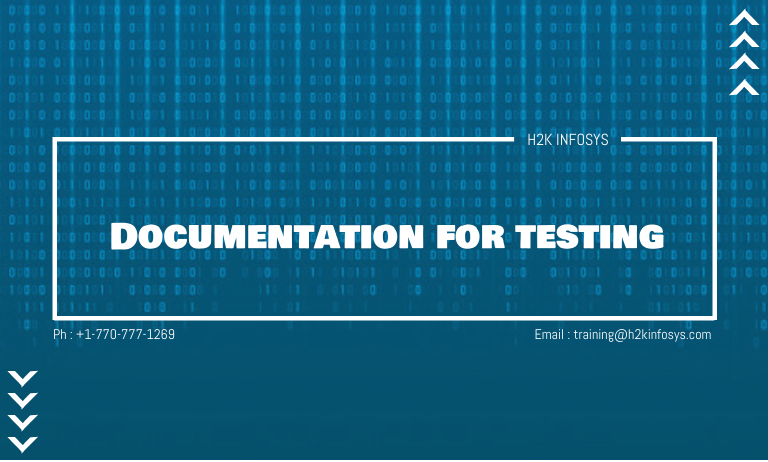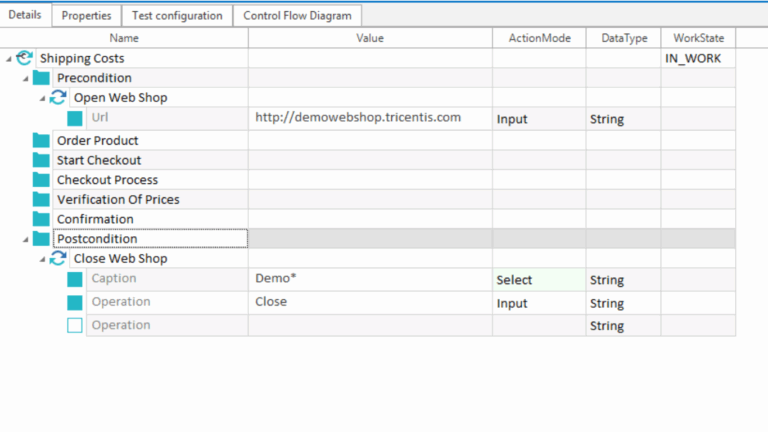Document testing is a Non-functional sort of testing, which may be written in pictorial form describing and defining, specifying, reporting and also certifying activities, requirements and procedures results. Documentation is as important to a product itself. If the documentation is poor and wrong obviously it will reflect in the quality of the software product and the vendor.
Documentation for testing helps in calculating the testing effort required, test coverage, requirement tracking etc. This portion includes the outline of some commonly used documented artefacts associated with software development.
The projects which consists all documents that have a high level of maturity. Carefully done documentation can save the time, efforts wealth of the organisation. Test documentation is written whenever the developers are busy in writing code.
Once the test document is ready the overall execution process depends on the test document. The primary goal of writing test document is to decrease and eliminate the doubts related to testing activities.
Types of test document are:
- Test Scenarios
- Test case
- Test Plan
- Requirement traceability matrix
- Test strategy
- Test data
- Bug Report
- Test execution report.
- Test Scenario-
Test Scenario is a document which explains in many different ways or may be combinations of testing applications. It consists of any inputs for testing. In the test scenario, the detail testing process, due to many associated test cases is available. In the test scenario, testers got to put themselves in the place of the user because they test the software from the user’s point of view. Preparation of scenario in the most critical part and it is necessary to seek advice or help from customer, stakeholders, and developers to prepare the scenario.
How to write the test scenario
The following are the steps to create the test scenario as tester:
- Read the necessary document such as (Business requirement document specification) and FRS (Functional Requirement specification) of the software which is under test.
- Determine all the technical aspects and objectives for each requirement.
- We have to find all the possible ways from which the user can operate the software.
- Supervisor of the project examines all the scenarios and they are evaluated by the stake holders of the project.
- The test scenario is the time saver activity.
2.Test plan
Test plan is a document which is prepared by the managers or may be test lead. It has all information about the testing activities. The test plan consists of multiple components like objectives, scope, approach, Test environment, Test methodology, Template, roles and responsibilities and entry and exit criteria, risk and contingencies etc.
The types of Test plan are:
- Master Test plan
- Phase Test plan
- Specific Test plan.
3.Requirement Traceability Matrix
The Requirement Traceability matrix is a document which makes sure that all the test cases have been covered. This document is created before the test execution process to verify that we did not miss writing any test cases for the particular requirement. The two main purposes of RTM are:
- bidirectional traceability: link the requirements and test cases
- track coverage: make sure all requirements have test cases and are tested.
The RTM template are
For example:
4.Test Strategy:
The test strategy is a high level document which verifies the test types to be executed for the product and describes what kind of technique has to be used and which also which module is going to be tested. Project manager can approve it. It consists of documentation formats, objectives, test processes, scope and customer communication strategy.
5.Test Data
The test data is input data or sample data used for testing. Test test data is added is prepared using standard techniques like boundary value analysis and equivalence class partition techniques. The test data is added while implementing the test case. Many people are having the test data in the excel sheet format and entered manually while performing the test case.
The test data can be used to verify the expected results which means that when the test data is entered, the estimated output will meet the actual result. The software is verified using both positive and negative input data.
6. Bug Report
The bug report is a document where we maintain a summary of all the bugs which are raised during the testing process. This is an important document for both the developers and test engineers because with the assistance of bug reports, they will easily track the defects, report the bug, change the status of bugs which are fixed successfully and also avoid their repetition in the process.
7. Test execution report-
Test execution report is document prepared by test leaders after the entire testing execution process is completed. The test summary defines the constancy of the product, and it contains the information namely modules and number of written cases. And each module features a separate spreadsheet of their respective module.
Benefits of Test Documentation:
- Documentation gives a clear idea of the quality of methods and objectives.
- It makes sure that the internal condition works when a customer uses software application.
- It makes sure about the stability of tasks and performance.
- It gives the feedback on preventive tasks.
- It gives feedback for our test plan cycle.
- It has objective evidence of the performance of the quality management system.
- If we write the test document, we can’t forget the values which we put in the first phase.
- Provides the project history, can be used during knowledge transfer while hiring new members in team in mid of project.
The drawbacks of Test document are:
- It is bit difficult because we should maintain the modification provided by the customer and parallel change in the document.
- If the test documentation is not proper it will depreciate the quality of the software application.
- If written by the person who does not have the proper product knowledge, can affect the software quality.
- Involves lot of effort in terms of cost and time of project






























17 Responses
Documentation For Testing:
Document testing is a Non-functional sort of testing, which may be written in pictorial form describing and defining, specifying, reporting and also certifying activities, requirements and procedures results. Documentation is as important to a product itself. If the documentation is poor and wrong obviously it will reflect in the quality of the software product and the vendor.
Documentation for testing helps in calculating the testing effort required, test coverage, requirement tracking etc. This portion includes the outline of some commonly used documented artefacts associated with software development.
Once the test document is ready the overall execution process depends on the test document. The primary goal of writing tes
t document is to decrease and eliminate the doubts related to testing activities.
Types test documents are:
Test Scenarios
Test case
Test Plan
Requirement traceability matrix
Test strategy
Test data
Bug Report
Test execution report.
1. TEST SCENARIOS:
Test Scenario is a document which explains in many different ways or may be combinations of testing applications. It consists of any inputs for testing. In the test scenario, the detail testing process, due to many associated test cases is available. In the test scenario, testers got to put themselves in the place of the user because they test the software from the user’s point of view. Preparation of scenario in the most critical part and it is necessary to seek advice or help from customer, stakeholders, and developers to prepare the scenario.
2.TEST PLAN:
Test plan is a document which is prepared by the managers or may be test lead. It has all information about the testing activities. The test plan consists of multiple components like objectives, scope, approach, Test environment, Test methodology, Template, roles and responsibilities and entry and exit criteria, risk and contingencies etc.
Many test plans are there:
Master test plan.
Phase test plan.
Specific test plan.
3. REQUIREMENT TRASABULITY MATRIX:
The Requirement Traceability matrix is a document which makes sure that all the test cases have been covered. This document is created before the test execution process to verify that we did not miss writing any test cases for the particular requirement. The two main purposes of RTM are:
. bidirectional traceability: link the requirements and test cases
. track coverage: make sure all requirements have test cases and are tested.
4.TEST STRATEGY:
The test strategy is a high level document which verifies the test types to be executed for the product and describes what kind of technique has to be used and which also which module is going to be tested. Project manager can approve it. It consists of documentation formats, objectives, test processes, scope and customer communication strategy.
5.TEST DATA:
The test data is input data or sample data used for testing. Test test data is added is prepared using standard techniques like boundary value analysis and equivalence class partition techniques. The test data is added while implementing the test case. Many people are having the test data in the excel sheet format and entered manually while performing the test case.
6. BUG REPORT:
The bug report is a document where we maintain a summary of all the bugs which are raised during the testing process. This is an important document for both the developers and test engineers because with the assistance of bug reports, they will easily track the defects, report the bug, change the status of bugs which are fixed successfully and also avoid their repetition in the process.
7.TEST EXCUTION REPORT:
Test execution report is document prepared by test leaders after the entire testing execution process is completed. The test summary defines the constancy of the product, and it contains the information namely modules and number of written cases. And each module features a separate spreadsheet of their respective module.
BENIFITS OF TEST DOCUMENTATION:
Documentation gives a clear idea of the quality of methods and objectives.
It makes sure that the internal condition works when a customer uses software application.
It makes sure about the stability of tasks and performance.
It gives the feedback on preventive tasks.
It gives feedback for our test plan cycle.
It has objective evidence of the performance of the quality management system.
If we write the test document, we can’t forget the values which we put in the first phase.
Provides the project history, can be used during knowledge transfer while hiring new members in team in mid of project.
DRAW BACKS OF TEST DOCUMENTATION:
It is bit difficult because we should maintain the modification provided by the customer and parallel change in the document.
If the test documentation is not proper it will depreciate the quality of the software application.
If written by the person who does not have the proper product knowledge, can affect the software quality.
Involves lot of effort in terms of cost and time of project
Document testing is a Non-functional sort of testing, which may be written in pictorial form describing and defining, specifying, reporting and also certifying activities, requirements and procedures results.
Documentation for testing helps in calculating the testing effort required, test coverage, requirement tracking etc.
Types of test document are:
1. Test Scenarios
2. Test case
3. Test Plan
4. Requirement traceability matrix
5. Test strategy
6. Test data
7. Bug Report
8. Test execution report.
Test Scenario:
Test Scenario is a document which explains in many different ways or may be combinations of testing applications.
How to write the test scenario?
1. Read the necessary document such as (Business requirement document specification) and FRS (Functional Requirement specification) of the software which is under test.
2. Determine all the technical aspects and objectives for each requirement.
3. We have to find all the possible ways from which the user can operate the software.
4. Supervisor of the project examines all the scenarios and they are evaluated by the stake holders of the project.
5. The test scenario is the time saver activity.
Test plan:
Test plan is a document which is prepared by the managers or may be test lead. It has all information about the testing activities.
The types of Test plan are:
1. Master Test plan
2. Phase Test plan
3. Specific Test plan.
Requirement Traceability Matrix:
The Requirement Traceability matrix is a document which makes sure that all the test cases have been covered. This document is created before the test execution process to verify that we did not miss writing any test cases for the particular requirement.
The two main purposes of RTM are:
1. bidirectional traceability: link the requirements and test cases
2. track coverage: make sure all requirements have test cases and are tested.
Test Strategy:
The test strategy is a high level document which verifies the test types to be executed for the product and describes what kind of technique has to be used and which also which module is going to be tested.
Test Data:
The test data is input data or sample data used for testing. Test test data is added is prepared using standard techniques like boundary value analysis and equivalence class partition techniques.
Bug Report:
The bug report is a document where we maintain a summary of all the bugs which are raised during the testing process.
Test execution report:
Test execution report is document prepared by test leaders after the entire testing execution process is completed.
Benefits of Test Documentation:
1. Documentation gives a clear idea of the quality of methods and objectives.
2.It makes sure that the internal condition works when a customer uses software application.
3. It makes sure about the stability of tasks and performance.
4. It gives the feedback on preventive tasks.
5. It gives feedback for our test plan cycle.
6. It has objective evidence of the performance of the quality management system.
7. If we write the test document, we can’t forget the values which we put in the first phase.
8. Provides the project history, can be used during knowledge transfer while hiring new members in team in mid of project.
Document Testing is non Functional Testing & it is required for the proper documentation as it directly effects the quality of software. Generally documentation testing helps in calculating the testing effort required,test coverage etc.
Test documentation saves lots of time & efforts of the organization & is generally created while developers are still doing coding.
Following are the Test documents..
1 Test scenario : This testing document is written from user point of view & usually tester takes advice from customer & developers to prepare it.
2 Test Plan: Is prepared by the managers & consist of information like objective, scoops ,test environment, test methodology etc.
3 Requirement Traceability Matrix : This document is created before the test execution process to verify that any test cases for particular requirement are not missing.
4 Test strategy
5 Test Data : Is input data or sample data that is going to be used for testing purpose.
6 Bug Report : It Is a document which gives the information about the bugs that are found during testing process. It is one of the most important document for developers to fix the defects.
7 Test Execution Report : This document is prepared by the test leaders & it gives the complete information of entire testing process.
Documentation for Testing
Document Testing is a non-functional sort of testing, which may be written in pictorial form describing and defining, specifying, reporting and certifying activities, requirements and result. If the documentation is not clear it may lead to poor quality of testing . Test document helps to calculate the effort required, test coverage.
Types of test document:
1 Test scenarios
The detailed testing process and many different ways and combination.
2 Test Plan
It consist many component like scope , scenario, environment, methodology etc.
Created by test manager or test lead.
3 Requirement Traceability Matrix
Draft for all the requirement and test cases .
4 Test Strategy
5.Test Data
Consists of all the input to be given while test execution in the point of end user.
6. Bug Report
Record of all the bug is found and fixed and status open. It is clear to track for the
retesting of fixed bug.
7. Test Execution Report
It contains the summary of the complete testing process created by test manager
once all the execution is complete.
Documentation for testing: Document testing is a non-functional sort of testing, which may be written in pictorial from describing and defining, specifying, reporting and also requirements and procedure results, the documentation is as important to a product it self, if the documentation is wrong it will effect to the project.
Types of test documents are : 1.test scenarios 2. test case 3. test plan 4. rtm 5. test strategy 6. test data 7. bug report 8. test execution report..
Test scenario: test scenario is a document its explains many different ways of testing application, it consists of any input for testing.
how to write the test scenario: read the FSD document and determine the all technical aspects and objectives for each requirement we have to find all the possible ways, test scenario is the time saver activity.
Test plan: test plan document is prepared by manager or test lead, it has all information about the testing activities, test plan consists of multiple components like objectives, scope, approach, test environment, test methodology, template, roles, and responsibilities and entry and exit criteria, risk and contingencies etc.
Requirement traceability matrix(RTM): RTM is a document which make sure that all the test cases have been covered, this document prepare before testing to verify we did not miss writing any test cases for requirement, rtm its created by Qa.
Test strategy: The test strategy is a high level document which verifies the test types to be executed for the product and describes what kind of technique has to be used and which also which module is going to be tested. Project manager can approve it. It consists of documentation formats, objectives, test processes, scope and customer communication strategy.
Test data: the test data is input data used for testing the test data is prepared using standard techniques like boundary value analysis and equivalence class partition techniques.
Bug report: The bug report is a document where we maintain a summary of all the bugs which are raised during the testing process. This is an important document for both the developers and test engineers because with the assistance of bug reports, they will easily track the defects, report the bug, change the status of bugs which are fixed successfully and also avoid their repetition in the process.
Test execution report; test execution report document is prepared by test leader after the entire testing execution is compleated, it contains all the summary and product details and all the modules data.
Documentation for Testing : is non functional testing written in pictorial form describing and defining requirements and procedures results. If documentation is wrong it affects the overall quality of the product.
It helps in calculating the testing effort required, test coverage etc. It saves time and efforts of the organization.
Types of Test documents are : 1. Test Scenarios 2. Test case 3. Test plan 4. RTM 5. Test strategy 6. Test Data 7. Bug Report 8. Test execution report
Benefits of Test documentation :
clear idea of the quality and methods
makes sure that the internal stability of tasks and performance
objective evidence of performance
gives feedback of test plan cycle
provides project history
Drawbacks
difficult to maintain the modification and parallel changes
if the test documentation is not problem it will depreciate the quality of the software application
involves lot of effort in terms of cost and time
This document describes what is documentation for testing, what are the components of a document, what are advantages and disadvantages of documentation for testing.
Document testing is a non-functional sort of testing, which may be written in pictorial form describing and defining, specifying,reporting and also certifying activities, requirements and procedures results. Documentation is as important as the product itself. If the documentation is incorrect or inaccurate it will reflect in the quality of the software product and the vendor.
Documentation for testing helps in calculating the time and effort required in testing a software product. A carefully and accurately prepared documentation can save time, effort and capital investment of the organization. The test document is written when the developers are writing code.
The primary goal of writing test documentation is to decrease and eliminate uncertainties related to testing activities.
Types of Test document are:
1. Test Scenarios – is a document which explains in many different ways or may be combination of testing applications.
2. Test Case
3. Test Plan – is a document which is prepared by the test managers or test lead. It outlines the testing activities, the objectives,
scope, approach, test environment, test methodology, template, roles and responsibilities, entry and exit criteria,
risks and contingencies etc
4. Requirement traceability matrix – is a document which makes sure that all test cases have been covered. The two main reason
for a RTM document is : bidirectional traceability. track coverage.
5. Test Strategy – is a high level document which verifies the test types to be executes for the product and describes what of
technique has to be used and which module is going to be tested.
6. Test Data – contains input data or sample data used for testing.
7. Bug Report – is a document where the summary of all the bugs raised during the testing process maintained.
8. Test execution report – is a document prepare by test leaders after the entire testing execution process is completed.
Ther advantages and disadvantages of test documents are also discussed here.
Here we see,
Documentation Testing
Types of test document are:
Test Scenarios
Test case
Test Plan
Requirement traceability matrix
Test strategy
Test data
Bug Report
Test execution report.
Document testing is a Non-functional testing, which may be written in pictorial form describing and defining, specifying, reporting and also certifying activities, requirements and procedures results. If the documentation is inaccurate it will affect the quality of the software delivered.
Documentation for testing helps in calculating the testing effort required, test coverage, requirement tracking etc.
Types of test documents are:
Test Scenarios
Test case
Test Plan
Requirement traceability matrix
Test strategy
Test data
Bug Report
Test execution report
Benefits of Test Documentation:
Documentation gives a clear idea of the quality of methods and objectives.
It makes sure that the internal condition works when a customer uses software application.
It makes sure about the stability of tasks and performance.
It gives the feedback on preventive tasks.
It gives feedback for our test plan cycle.
It has objective evidence of the performance of the quality management system.
If we write the test document, we can’t forget the values which we put in the first phase.
Provides the project history, can be used during knowledge transfer while hiring new members in team in mid of project.
The drawbacks of Test document are:
It is bit difficult because we should maintain the modification provided by the customer and parallel change in the document.
If the test documentation is not proper it will depreciate the quality of the software application.
If written by the person who does not have the proper product knowledge, can affect the software quality.
Involves lot of effort in terms of cost and time of project
Software testing requires a good documentation.
Several kinds of test documents are used in testing, such as,
Test Scenarios
Test Case
Test Plan
RTM (Requirement Traceability Matrix)
Test Strategy
Test Data
Bug Report
Test Execution Report
Document testing is a Non-functional sort of testing, which may be written in pictorial form describing and defining, specifying, reporting and also certifying activities, requirements and procedures results. Documentation is as important to a product itself. If the documentation is poor and wrong obviously it will reflect in the quality of the software product and the vendor.
Documentation for testing helps in calculating the testing effort required, test coverage, requirement tracking etc. Test documentation is written whenever the developers are busy in writing code. The primary goal of writing test document is to decrease and eliminate the doubts related to testing activities.
Types of test document are:
1.Test Scenarios
2.Test case
3.Test Plan
4.Requirement traceability matrix
5.Test strategy
6.Test data
7.Bug Report
8.Test execution report.
Test Scenario-Test Scenario is a document which explains in many different ways or may be combinations of testing applications. It consists of any inputs for testing.
2.Test plan-Test plan is a document which is prepared by the managers or may be test lead. It has all information about the testing activities.
3.Requirement Traceability Matrix-The Requirement Traceability matrix is a document which makes sure that all the test cases have been covered. The two main purposes of RTM are:
bidirectional traceability: link the requirements and test cases
track coverage: make sure all requirements have test cases and are tested.
4.Test Strategy-The test strategy is a high level document which verifies the test types to be executed for the product and describes what kind of technique has to be used and which also which module is going to be tested. Project manager can approve it.
5.Test Data-The test data is input data or sample data used for testing. Test test data is added is prepared using standard techniques like boundary value analysis and equivalence class partition techniques.
6. Bug Report-The bug report is a document where we maintain a summary of all the bugs which are raised during the testing process. This is an important document for both the developers and test engineers .
7. Test execution report-Test execution report is document prepared by test leaders after the entire testing execution process is completed.
Documentation for Testing
Document Testing is a non-functional sort of testing, which may be written in pictorial form describing and defining, specifying, reporting and certifying activities, requirements and result. If the documentation is not clear it may lead to poor quality of testing . Test document helps to calculate the effort required, test coverage.
Types of test document:
1 Test scenarios
The detailed testing process and many different ways and combination.
2 Test Plan
It consist many component like scope , scenario, environment, methodology etc.
Created by test manager or test lead.
3 Requirement Traceability Matrix
Draft for all the requirement and test cases .
4 Test Strategy
5.Test Data
Consists of all the input to be given while test execution in the point of end user.
6. Bug Report
Record of all the bug is found and fixed and status open. It is clear to track for the
retesting of fixed bug.
7. Test Execution Report
It contains the summary of the complete testing process created by test manager
once all the execution is complete.
Document testing is a Non-functional sort of testing, which may be written in pictorial form describing and defining, specifying, reporting and also certifying activities, requirements and procedures results. If the documentation is poor and wrong obviously it will reflect in the quality of the software product and the vendor. Documentation for testing helps in calculating the testing effort required, test coverage, requirement tracking etc.
he primary goal of writing test document is to decrease and eliminate the doubts related to testing activities.
Types of test document are:
1.Test Scenarios- consists of any inputs for testing.
2.Test case
3. Test Plan- consists of multiple components like objectives, scope, approach, Test environment, Test methodology, Template, roles and responsibilities and entry and exit criteria, risk and contingencies etc.
4.Requirement traceability matrix- a document which makes sure that all the test cases have been covered.
5.Test strategy- verifies the test types to be executed for the product and describes what kind of technique has to be used and which also which module is going to be tested.
6.Test data- input data or sample data used for testing
7.Bug Report- document where we maintain a summary of all the bugs which are raised during the testing process.
8.Test execution report- document prepared by test leaders after the entire testing execution process is completed.
Document testing is a Non-functional testing, which may be written in pictorial form describing and defining, specifying, reporting and also certifying activities, requirements and results.
Types of test document are:
Test Scenarios
Test case
Test Plan
Requirement traceability matrix
Test strategy
Test data
Bug Report
Test execution report
Document testing is a Non-functional sort of testing, which may be written in pictorial form describing and defining, specifying, reporting and also certifying activities, requirements and procedures results. Documentation is as important to a product itself. If the documentation is poor and wrong obviously it will reflect in the quality of the software product and the vendor.
Types of test document are:
Test Scenarios
Test case
Test Plan
Requirement traceability matrix
Test strategy
Test data
Bug Report
Test execution report.
Benefits of Test Documentation:
1)Documentation gives a clear idea of the quality of methods and objectives.
2)It makes sure that the internal condition works when a customer uses software application.
3)It makes sure about the stability of tasks and performance.
4)It gives the feedback on preventive tasks.
5)It gives feedback for our test plan cycle.
6)It has objective evidence of the performance of the quality management system.
7)If we write the test document, we can’t forget the values which we put in the first phase.
8)Provides the project history, can be used during knowledge transfer while hiring new members in team in mid of project.
Document testing is a Non-Functional sort of testing, which may be written in pictorial form describing and defining, specifying, reporting and also certifying activities, requirements and procedures results. Documentation is as important to the product itself. If the documentation is poor and wrong it will reflect in the quality of the software product and the vendor.
The types of test documents are Test scenarios, test cas, test plan, requirement traceability matrix, test strategy, test date, bug report and test execution report.
Test scenario- is a document which explains in many different ways or may be combination of testing applications. In the test scenario, testers got to put themselves in a place of the user because they test the software from the user point of view.
Test Plan- Test plan is a document which is prepared by the managers or may be test lead. It has all information about the testing activities. The test plan consists of multiple components like objectives, scope, approach, Test environment, Test methodology, Template, roles and responsibilities and entry and exit criteria, risk and contingencies etc.
Requirement traceability matrix- is a document which makes sure that all the test cases have been covered. The document is created before the test execution process to verify that we did not miss anything
Test Strategy-The test strategy is a high level document which verifies the test types to be executed for the product and describes what kind of technique has to be used and which also which module is going to be tested. Project manager can approve it. It consists of documentation formats, objectives, test processes, scope and customer communication strategy.
Test Data- is input data or sample data used for testing, it is data is added is prepared using standard techniques like boundary value analysis and equivalence class partition techniques.
The bug report is a document where we maintain a summary of all the bugs which are raised during the testing process. This is an important document for both the developers and test engineers because with the assistance of bug reports, they will easily track the defects, report the bug, change the status of bugs which are fixed successfully and also avoid their repetition in the process.
Test execution report is document prepared by test leaders after the entire testing execution process is completed. The test summary defines the constancy of the product, and it contains the information namely modules and number of written cases. And each module features a separate spreadsheet of their respective
Documentation testing is a Non-functional sort of testing, which may be written in pictorial form describing and defining, specifying, reporting and also certifying activities, requirements and procedures results. Documentation is as important to a product itself. If the documentation is poor and wrong obviously it will reflect in the quality of the software product and the vendor.
Types of test document are:
Test Scenarios
Test case
Test Plan
Requirement traceability matrix
Test strategy
Test data
Bug Report
Test execution report.
Benefits of Test Documentation:
1)Documentation gives a clear idea of the quality of methods and objectives.
2)It makes sure that the internal condition works when a customer uses software application.
3)It makes sure about the stability of tasks and performance.
4)It gives the feedback on preventive tasks.
5)It gives feedback for our test plan cycle.
6)It has objective evidence of the performance of the quality management system.
7)If we write the test document, we can’t forget the values which we put in the first phase.
8)Provides the project history, can be used during knowledge transfer while hiring new members in team in mid of project.